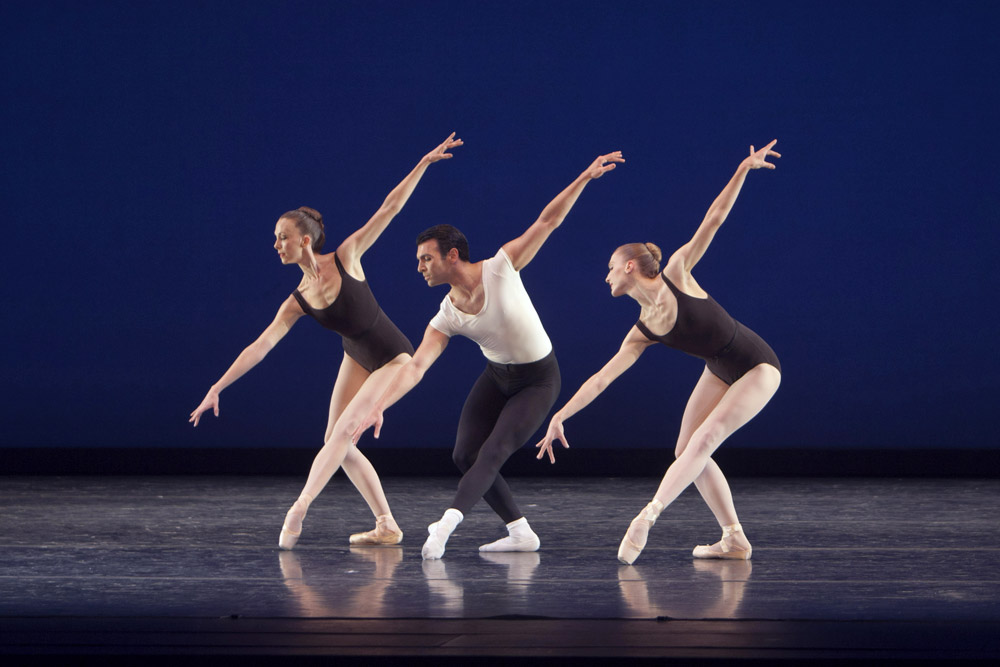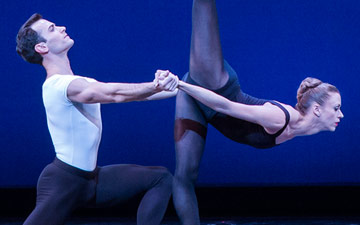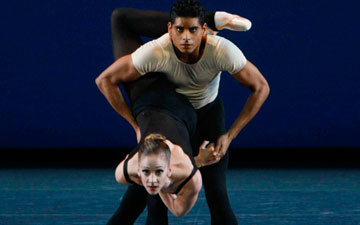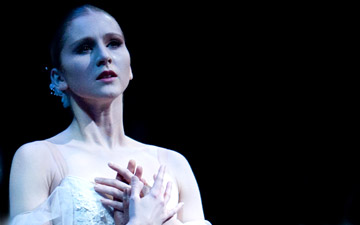
© Lindsay Thomas. (Click image for larger version)
Pacific Northwest Ballet
Concerto Barocco, Apollo, Agon
New York, City Center
13 February 2013
www.pnb.org
www.nycitycenter.org
Pacific Northwest Ballet Dances Balanchine
In New York one can begin to feel proprietary about Balanchine, to form the illusion that his choreography is a local specialty, the province of a select group of dancers, all of them employees of New York City Ballet. But this is mere local pride. As with everything else, the Balanchine repertoire has branched out, globalised. His works are performed all over the world, from St. Petersburg to Buenos Aires and points in between. Unlike Prada handbags, Balanchine ballets never look quite the same from place to place. One of the thrilling aspects of dance (and anything that involves the body) is that it is constantly in flux. Technique changes, steps are filtered through a company – or national – style, and choreography is remembered differently by different people. Someone who learned a ballet in the fifties will have performed slightly different steps than a ballerina dancing it twenty years later (or earlier). She will then pass on those alternate steps to a particular group of dancers under her tutelage. Not to speak of personal style. Just think of some of the ballerinas who have performed in Concerto Barocco: Suzanne Farrell, Diana Adams, Gelsey Kirkland, Allegra Kent, Tanaquil LeClercq. It’s a surprise we recognize the ballet at all.
For out-of-town companies, performing Balanchine in New York is a particular hurdle because the audience’s eyes are so imprinted with the versions it sees at New York City Ballet night after night. At the same time, the experience of watching these alternative versions is the richer for having something to compare them to. Pacific Northwest Ballet, led by the much-loved former New York City Ballet danseur Peter Boal is particularly qualified in this respect; not only does it have Boal, but there is also Francia Russell, a Founding Artistic Director who stages most of the Balanchine ballets, and who danced for Balanchine from 1956 to 1961. To give you an idea, this is the period that begins with Allegro Brillante and culminates with Raymonda Variations. Furthermore, Boal’s presence has lured a few former City Ballet dancers, including Seth Orza and the shining jewel in its crown, the Brazilian-born Carla Körbes (Korbes interview).
This week the Seattle-based troupe is making its first full-company visit in twenty years. It opened its four-day run at City Center with a program of Balanchine masterpieces: Concerto Barocco (1941), Apollo (1928), and Agon (1957). A bold move since all three are in constant rotation just a few blocks uptown. (The subsequent performances will mark a radical change of pace, as they feature Jean-Christophe Maillot’s minimalist, evening-length Roméo et Juliette.)

© Lindsay Thomas. (Click image for larger version)
But this was the night for the hardcore Balanchine watchers. The audience was full of former and current dancers, company directors, teachers. With the exception of Apollo, which was danced in a version virtually identical to the one we see here – and set on the company by Boal himself – there were lots of subtle variations to be taken in, enough to make the ballets feel noticeably different even if one could not pinpoint exactly why. Agon seemed less formal, more pared-down; in the “Gaillard,” for example, the two women did not do their little claps, so evocative of court dances. Nor did the two women count out Stravinsky’s odd number of beats with their arms and hands. These elements must have been introduced into the ballet after Russell’s tenure. And in the opening of the third movement of Concerto Barocco, the female soloists’ circuitous route to the front of the stage set a less conversational, more indirect tone. Most of the changes, of course, are barely noticeable, or noticeable only on a subconscious level. But their effect is cumulative, injecting a sense of newness (and surprise) into these familiar, almost houseworn works. It would be interesting to watch them all again and see even more.
Some of the contrasts were musical; here we enter murkier territory. In general, the accents and phrasing of the dancers felt a little fuzzy throughout the evening – with the exception of Apollo. Every Balanchine phrase has its highs and low; it’s this constant interplay between accentuated steps and subtle patter leading up to them that holds one’s interest. You hold your breath, you release it, and then you hold it again. When the accents are muffled, the tension between the steps and the music relaxes. The ballets become flatter. Concerto Barocco suffered the most. It was also the first ballet on the program; the dancers looked slightly nervous, and there had been a last-minute casting change (Karel Cruz was replaced by Batkhurel Bold). All this must be taken into account. But whatever the reason, some details were blurred. Changes of direction and shifts of weight were too timid. The un-classical way Balanchine uses the dancers’ hips, jutting them forward in order to create a kind of arc with the body – taut like a bow – were reduced to decorous, little bumps. This is just one of the ways Balanchine used vulgarity to create drama. In the pas de deux, Laura Gilbreath, dancing with a nervous-looking Batkhurel Bold (thrown on at the last minute) seemed to be playing it safe, not allowing herself to hover in off-kilter balances, or to pull too far from her partner. There was little sense of risk or élan. More seriously, throughout the ballet the steps lagged just a fraction behind the music – breaking the magical illusion of steps and music being born of the same impulse. All in all this was a correct, but not a magical performance.

© Lindsay Thomas. (Click image for larger version)
The company looked more assured in the closing piece, Agon. Maria Chapman, in particular, stood out for her attack and sense of style. She used her shoulders to great effect in the Spanish-tinged Bransle Gay, accompanied by castanets in the pit and by the clapping of two men onstage. (Incidentally, the day before at a Studio 5 lecture demonstration, Damian Woetzel had informed a small audience that Balanchine added the clapping during the company’s Russian tour in 1962, because the percussionist in the pit was having trouble keeping time with the dancer.) There’s a wide range of body types among the men at PNB, which inevitably alters the effect of the opening and closing tableaux, in which four men saunter and lunge, at first with their backs toward the audience. Here they not only looked, but also moved, differently, too differently. (In general I would venture, on admittedly slender evidence, that the women in the company seem stronger than the men.) Even so, Jonathan Porretta did a fine job in the “Sarabande,” advancing in those crazy kick-jumps, then launching into his heel-tapping dance accompanied by Stravinsky’s spooky xylophone. (PNB’s orchestra, led by Allan Dameron, played Stravinsky more vividly than it had Bach, highlighting the colors of the individual instruments.) But here again, the dancers could have gone further, making bolder shapes, drawing attention to the contrasts of pure, Baroque forms and off-kilter, surprising shapes. Agon can, and should, feel more modern. This was especially true in the pas de deux, which begins like a court presentation (with not one but two decorous bows) and then proceeds through a gauntlet of extreme entanglements: legs splayed, man down on his back, fetishistic handling of the woman’s feet, all climaxing with the striking image of the woman stepping over the man’s shoulder – pelvis sliding past his face – and then folding herself over his kneeling body like a predatory animal. In the right hands, it’s like a civilized battle to the death, endowed with a powerful erotic charge. As danced by Lesley Rausch and Bold, the duet’s sexual narrative remained hidden.

© Lindsay Thomas. (Click image for larger version)
These two respectable performances bookended a rendition of Apollo remarkable mainly for the beauty of Carla Körbes’s interpretation of Terpsichore, muse of dance. Amid a roster of strong but not uniformly captivating dancers, Carla Körbes stood out all the more. She doesn’t project, exactly, but rather illuminates the steps from within, with a subtle warmth and expansiveness. Her interpretation is very simple, very internal, quietly sensual. Orza, a colleague from as far back as the School of American Ballet, is a serious, solidly-handsome Apollo. His dancing is more mortal than divine, but he engages with the choreography and he knows where its accents lie. Orza tests his strength, kicking and jabbing the air, checking his balance in awkward poses on bent legs, always looking (and listening) for guidance from the Muses and the Gods. (Pacific Northwest does the same shortened version of the ballet favored by NYCB, which doesn’t include a birth scene or an ascent to Mount Olympus.) Interestingly, these dancers looked less cowed by the ballet than City Ballet’s; it’s almost as if they haven’t been told that it is Very Important Ballet, and so much the better. They’re less prone to overact or lay on the charm, allowing the steps to speak for themselves. Körbes raises the stakes immeasurably, her energy ebbing and flowing, suffusing the choreography with nuances, molding the transitions with her fluid lines, sliding into her jumps or using her hips to add just an extra hint of sensuality. She reveals the subtle shifts in her interaction with Apollo as well, from a slightly haughty first approach to a tentative attraction, followed by a playful recognition, and finally a swooning harmony. She allows her innate sense of taste (the subject of Woetzel’s lecture demonstration) to guide her to this quiet nirvana. In other words, she has the instincts of a natural Balanchine ballerina.

















[…] Apollo was staged by Peter Boal, now the company’s artistic director. Here’s my review, for […]
As always, your writing is deliciously illuminating. I’ve seen these ballets umpteen times, and haven’t noticed half of what you describe — but then, I have no ballet training. I’d like to add something you may or may not be aware of, but was the topic of a Columbia University dance student’s paper: that some of the movements in the pdd are (theoretically) based on the physical therapy that Mr. B. did to hopefully help Tanaquil Le Clerc. This was one of the four ballets he choreographed after his year break trying to “cure” his wife.
Deep in my computer I have a copy of that paper and could dig it out. Other people have commented on this,though I can’t recall who/where. Thanks for reporting on Damian’s comment about the Bransle Gay. I never connected the castanets with a Spanish look (duh), I was too busy trying to identify Renaissance steps.
Thanks, as always,
Seyna
Thank you Seyna! I had read that as well—it’s a very interesting thing to think about , isn’t it. What’s marvelous about Balanchine—any great choreographer, really—is how he was able to incorporate complete disconnected references and material and use them for his own purposes, like the lights in Picadilly Circus or the fingers in apollo.
Cheers!
M